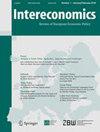德国企业的循环利用程度如何?
Q1 Economics, Econometrics and Finance
引用次数: 0
摘要
循环经济的基本概念是通过尽量减少经济系统的材料和能源需求以及废物和排放,尽可能长时间地利用资源(Geissdoerfer等人,2017;negigan et al., 2022)。它关注整个价值链或完整的产品生命周期:包括原材料的提取,产品设计,半成品和成品和产品的制造以及材料的使用和后续回收。理想情况下,产品设计为尽可能长寿命,重复使用和回收,并在设计阶段使用适当的原材料。这使得产品在其生命周期结束时可以重复使用、翻新或返回到材料循环中。产品和服务系统需要适应这一点,并且有新的商业模式来满足这些要求(德勤和德国工业联合会,2021)。作为循环经济的重要支柱,运转良好的二级原材料市场必须跨境运作,以确保需求。循环经济的目标是优化和延长资源的使用,最终在一个闭环中回收和再利用资源。本文章由计算机程序翻译,如有差异,请以英文原文为准。
How Circular Are Businesses in Germany?
The basic concept of a circular economy is to use resources for as long as possible by minimising the material and energy demands as well as the waste and emissions of an economic system (Geissdoerfer et al., 2017; Neligan et al., 2022). It focuses on the entire value chain or the complete product life cycle: this includes the extraction of raw materials, the product design, the manufacturing of semi-finished and finished goods and products as well as the use and subsequent recycling of materials. Ideally, products are designed for the longest possible lifetime, reuse and recycling, and appropriate raw materials are used during the design phase. This enables the reuse, refurbishment or return of products to the material cycle at the end of their lifetime. Product and service systems need to be adapted to this, and there is scope for new business models to meet these requirements (Deloitte and The Federation of German Industries, 2021). Well-functioning markets for secondary raw materials as an essential pillar of a circular economy have to operate across borders to ensure demand. The goals of a circular economy are to optimise and prolong the use of resources and ultimately to return and reuse resources in a closed loop.
求助全文
通过发布文献求助,成功后即可免费获取论文全文。
去求助
来源期刊

Intereconomics
Economics, Econometrics and Finance-Economics, Econometrics and Finance (miscellaneous)
CiteScore
5.00
自引率
0.00%
发文量
66
审稿时长
16 weeks
期刊介绍:
Intereconomics publishes papers dealing with economic and social policy issues in Europe respectively in Euroland. The journal consists of the sections editorial, forum and articles. The editorial section contains brief comments on current questions of economic policy in Europe or effecting Europe. In the forum, several authors (researchers, politicians, representatives of trade unions and of employers associations etc.) voice their opinions on one particular current economic policy problem effecting Europe. The articles deal with economic policy issues and trends in Europe. They are mostly written by researchers in economics. Officially cited as: Intereconomics
 求助内容:
求助内容: 应助结果提醒方式:
应助结果提醒方式:


